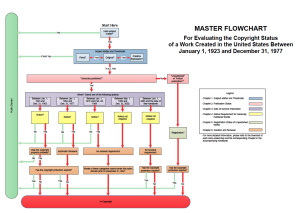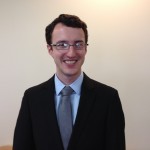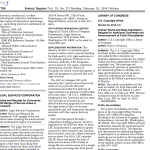Is it in the Public Domain? Review by Peter Hirtle
[UPDATE from Peter Hirtle: That didn’t take long. The authors of the handbook have responded to my specific issues below by updating and/or correcting the handbook. A new version is available at http://www.law.berkeley.edu/files/FINAL_PublicDomain_Handbook_FINAL(1).pdf. A very good resource has become even better.]
Stanford Copyright and Fair Use Center Advisory Board Member Peter Hirtle reviews Is it in the Public Domain?
It is very difficult to determine whether works are in the public domain in the United States. That is why I had to create my duration chart as an aide–mémoire: any time I tried to remember the various options, I got them wrong. It is also why I felt compelled to write an article highlighting some of the traps lurking within the seeming clear-cut categories. And it is why Stephen Fishman needs 700+ pages in his legal treatise, Copyright and The Public Domain. Continue reading →
Public Domain Handbook – Samuelson clinic
The Samuelson clinic has put together what looks like a useful, thorough new handbook to help you determine if a work is in the public domain. http://www.law.berkeley.edu/files/Final_PublicDomain_Handbook.pdf
Most helpful is the complete FLOW CHART. We’ll put both the handbook and the flowchart in our CHARTS AND TOOLS section for your hand reference. http://www.law.berkeley.edu/files/Final_PublicDomain_Flowcharts(6).pdf
Future proofing copyright
The flawed copyright system has an impact on creative economy. Copyright’s influence on digital opportunities in the UK’s creative economy provided impetus for broad scale initiatives for improvement. Audience expectations have changed dramatically. #mediaxfocpod
mediaX connects businesses with Stanford University’s world-renowned faculty to study new ways for people and technology to intersect.
Who’s the Owner: A White Paper on “Improving Copyright Information Management: An Investigation of Options and Areas for Further Research”
The U.S. Copyright Office came to Stanford Law School yesterday to conduct a roundtable on Recordation Reengineering, The Stanford Law School Law and Policy Lab submitted comments and a thoughtful White Paper, and live tweeted the proceeding along with us (see @slspolicylab and @fairlyused). The Law and Policy Lab was represented at the roundtable by Peter Holm, third year law student. We interviewed Peter to get the essence of the issue and the White Paper, which is available as document 23 on the Copyright Office comments page.
The roundtable was conducted by Robert Brauneis, Abraham L. Kaminstein Scholar in Residence, U.S. Copyright Office.
The White Paper was submitted to Brauneis by Ariel Green, Sean Harb, Peter Holm, Kingdar Prussien, Kasonni Scales, and Juliana Yee, Copyright Policy Lab Practicum
Mary Minow: What was the impetus that led Stanford to research and write this White Paper?
Peter Holm: The Copyright Office contacted Stanford initially and Professor Paul Goldstein contacted us. I took a copyright class in the Fall of 2012 with Professor Goldstein. He emailed a few of us over the summer to see if we were interested. He described it as a chance to offer concrete suggestions to modernize the Copyright Office operations.
Minow: That sounds broad. When did the focus narrow to copyright document recordations?
Holm: That narrower focus developed in the Fall as we spoke with Maria Pallante, Register of Copyrights; Jacqueline Charlesworth, General Counsel, United States Copyright Office, and then with Professor Bob Brauneis who is there as a scholar in residence on these issues.
Minow: Why does this matter?
Holm: To have economic value, an owner of copyrighted works has to be able to sell and make his works available. If you don’t know who the owner is, you can’t make those transactions and the works lose value, so availability of this information is integral.
Minow: How do people find out now about who owns what copyrights?
Holm: It varies by industry. Neither registration of copyrights nor recordation of copyright transfers are required, but both have benefits to the owner. Because taking these steps is voluntary, the amount of information available for any given work varies considerably. So for example, in the music industry, there is extensive ownership information and licensing availability through ASCAP, BMI and the Harry Fox agency. So if I want to play Elton John at a party open to all Stanford students, I can get a license from those collecting societies and not worry about who owns the rights.
Whereas if I find a book in the library, published in 1955 and I want to use it, it’s harder to find information. There are probably records at the Copyright Office for the initial owner, as registration used to be required, but subsequent transfers might not have been recorded, so many questions remain. Did he transfer the copyright at some point? If not, is the author still alive? Did it go to his heirs, and who are they?
There is a substantial cost to investigating this, and often one doesn’t know who to talk to.
Minow: What’s the gist of your proposal?
Holm: It’s not a proposal per se. It’s really a list of options and tradeoffs. We look at the role of the copyright office. Should it hold a giant database, partner with third parties? Really it comes down to how do we best provide access to the public and get the information they need without overly burdening authors with unnecessary requirements? We don’t want to make it too hard for them to exercise their rights to transfer works, since transfers are potentially beneficial.
Minow: What are the benefits of recording transfer documents, since it’s not required?
Holm: It gives constructive notice of the transfer. Also, if you record a transfer document there is a presumption of validity for that document over subsequent instruments of transfer of the same title.
Minow: Thanks for talking with us today.
——
Peter Holm is a third year law student at Stanford Law School.
Mary Minow is the Executive Editor of the Stanford Copyright & Fair Use page.
Deadline: April 14th. Public invited to weigh in on orphan works – US Copyright Office
ORPHAN WORKS is red hot again. After a number of failed legislative attempts and a couple of high profile court cases, its back to the drawing board, albeit a better defined drawing board. On the one hand, most everyone agrees that for true orphans, it would be great for us all to be able to digitize, copy, adapt, distribute and otherwise use them. On the other hand, how do we know it’s a true orphan? What if there is an “orphan” owner?
The Copyright Office just held two days of public roundtables on Orphan Works (See twitter #orphanworks for some flavor of the sessions). The Copyright Office has now opened up the floodgates for public comment from those of us who were not in D.C. Continue reading →
Technological Protection Measures – lecture by William Fisher
CopyrightX: Lecture 11.3, Technological Protection Measures by William Fisher Published on Feb 20, 2014
This video is licensed under the Creative Commons Attribution-Noncommercial-Sharealike 2.5 License, the terms of which are available here: http://creativecommons.org/licenses/b….
This lecture was prepared for the course CopyrightX, which was offered by William Fisher under the auspices of Harvard Law School and HarvardX during Spring 2014. For more information on CopyrightX, please see http://copyx.org
CopyrightX lectures fully available to the public
The highly successful open course from Harvard prepared and delivered by Prof. William Fisher is in its Spring 2014 incarnation. It has a clear organization that lets you dive into a specific area that interests you like Technological Protection Measures. A full set of lectures and other resources available to the public online. I especially like the copyright concept maps. A vision for the course can be found here.
Unusual number of interesting copyright decisions
Justia attorneys have summarized a number of unusually interesting recent copyright decisions that I’d like to call to your attention. If you click through, you’ll see human written, human readable case summaries.
Garcia v Google – or the Innocence of the Muslims case, aligns copyright interests with an actress’s interest in controlling the use of her performance but is juxtaposed to free speech interests by Google/YouTube
Anderson v. LaVere – heirs of Mississippi blues musician Robert Johnson dispute over royalties
Brownstein v. Lindsay – about whether a court has authority to cancel a copyright registration when a plaintiff’s authorship has been “expressly repudiated”
Swatch v Bloomberg – in which Bloomberg obtained a copy of a conference call recording discussion a company’s recent earnings report
U.S. Case Law is in the public domain – why isn’t it all free online?
On January 16, 2014, Stanford’s Program in Law, Science & Technology along with CodeX: The Stanford Center on Legal Informatics hosted a discussion with UC Berkeley Professor Brian Carver to discuss the Free Law Project, which provides free public access to primary legal materials, develops legal research tools, and supports academic research on legal corpora.






